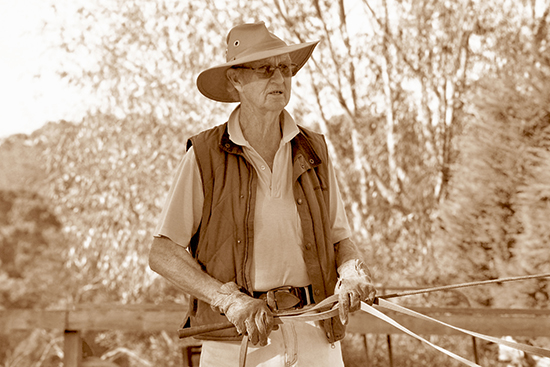 Malcolm Barns is one of the unsung heroes of Australian Dressage. A rider whose huge natural talent carried him to a win in Australia’s first ever Three Day Event over 50 years ago, and then saw him star in the show ring, and emerge as one of our first serious dressage competitors. Malcolm also possessed the insight that to really learn his art he needed to travel, and to travel to the home of dressage – Germany.
Malcolm Barns is one of the unsung heroes of Australian Dressage. A rider whose huge natural talent carried him to a win in Australia’s first ever Three Day Event over 50 years ago, and then saw him star in the show ring, and emerge as one of our first serious dressage competitors. Malcolm also possessed the insight that to really learn his art he needed to travel, and to travel to the home of dressage – Germany.
He brought back ‘crazy’ ideas with him. At a time when horses were jacked up and double bridled into a very artificial outline, or falling onto their forehands, it was Malcolm who taught that they must stretch and relax and find their rhythm and balance. A tall thin man, Malcolm has the soul of a dancer or a musician, for him rhythm is one of those essential prerequisites to riding well. I remember well, and with great affection, many of his group lessons at Oakwood, where he would have us singing the beat of the trot as we made our way in serried ranks around the School, “left, left, left, left…”
And poor Malcolm trying to explain the half-halt to a rider whose response was, “why half-halt? I either stop the horse or I don’t!”
In 2010 Malcolm travelled again, this time to Portugal and attended a dressage training seminar. Malcolm was inspired to make this contribution, which is relevant to current post-London 2012 discussion.
Let Malcolm tell the story in his own words:
Australians are rather disadvantaged compared to Europeans if they want to learn to ride a horse. We pester until mum and dad buy us a pony, or we can borrow a friend’s horse, probably an ex-racehorse – clamber on and away we go. For self-preservation we hang onto the reins like grim death and grip with our legs and already we’ve learnt the basic bad habits that will probably be with us for life.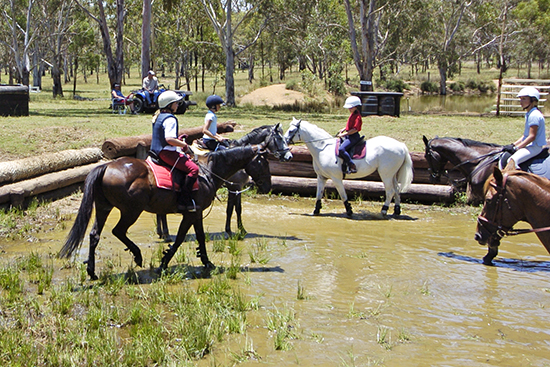
We then have to get used to falling off when the horse shies and we hang on tighter after stories of being dragged around the paddock upside down with one foot caught in the stirrup, then the horse rears, bucks, or just won’t go – probably the safest alternative.
By comparison, in most European countries, you can go to the local Riding School, of which there are plenty with a variety of school horses and qualified instructors and become fairly proficient in about 12 months with one half hour a week on the lunge, or better still, two lots of fifteen minutes in a shared half hour lesson, so you get a short physical rest while the instructor is concentrating on the other rider, but you are listening and observing – and you now have the added stimulus of competition.
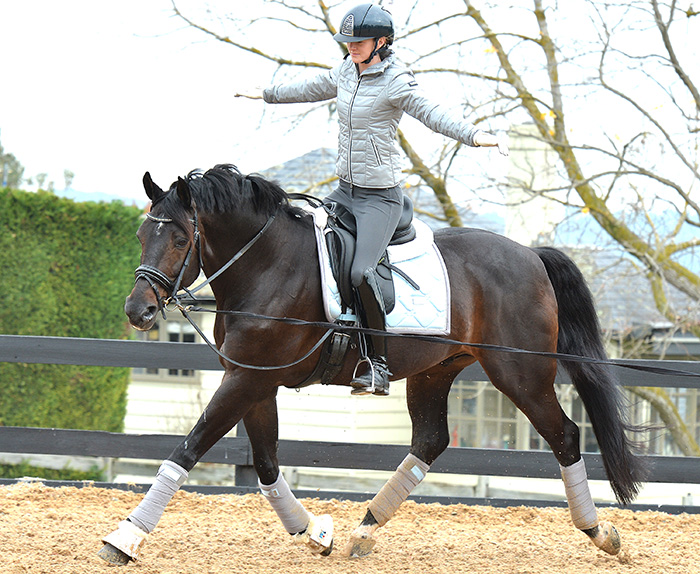
In Europe, we would start off with short periods of slow walking and trotting, so we can feel how the horse moves and we can follow the movement. Canter comes later when we have more confidence. We learn to ride without stirrups, swing our arms, touch our toes, lift our knees, one at a time while holding on to the pommel of the saddle or neck strap.
Over time we have sat on at least half a dozen differently shaped horses with quite different movement and probably two or three different qualified instructors. We are happily cantering. Now we are ready to ride in a group on well-behaved school horses, still with guidance from an instructor. We can canter individually and learn turns on the forehand and leg yielding as the horses are well schooled in these exercises.
Being more efficient with our seat and lower legs now, we are better able to push our horses into a more athletic walk, trot and canter, without teaching them to run. As we are getting the feel of lateral exercises, which engage the horse’s hind legs, the horse is encouraged to lower his neck and round up his back. This is similar to teaching a child to lower his head to open up his shoulders when he is learning to swim, rather than dog paddle with a hollow back.
So, by now we have an independent seat, we don’t have to hang onto the reins to avoid falling off, and we stay balanced in the saddle and follow the horse’s movement. We have learnt not to contort our muscles and grip unless we have lost our balance and hope to avoid a fall. Contracting muscles prevent us from being supple and this interferes with the horse’s suppleness and movement. We may learn to do a little jumping also on the lunge to further secure our balance and perhaps decide to specialise in dressage, showjumping or eventing or simply enjoy riding for exercise or pleasure.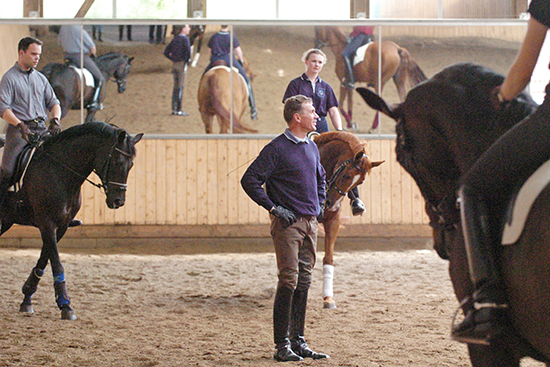
Now, how are they getting on back in Australia?
Now we are back in Aussie and we have lots of interest and visits from enthusiastic European trainers. Seeing Australian riders in action must be a bit of a culture shock.
In Europe, most riders can sit comfortably and the horses are able to move without the baggage in the saddle unnecessarily disturbing them. However, there is something about the way Australian riders sit that does disturb these trainers and because they themselves were taught how to sit first, they do not expect to have to explain the mechanics of the seat, so it is difficult for them to recognise or fix the problems of the Australian riders. They talk to us about improving our basics, and we have no idea what they are talking about.
Most Australian riders are also ‘hand dominant’ – they hang on the reins and the horses defend themselves by hanging back – on the forehand! They move with short necks, well behind the vertical; neither horse or rider is in self-carriage, but in an un-progressive compromise. Horses are most generous and do their best in the situation.
It is also very strange that most of these instructors say much the same things that the riders have been hearing over and over for years, but there isn’t all that much improvement. What is the problem?
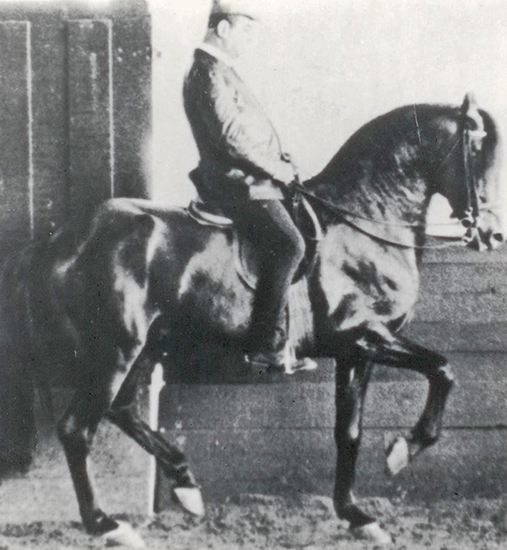 In Europe, if they are tall, short, thick, thin, chubby, it doesn’t matter – because of their early exercises, and watching role model competition riders, then most of them can sit in, and sit deep. By contrast, most of our riders are ‘perching’, trying as they have been taught to ‘sit up’, shoulders back, heels down, etc., they are stiff as boards. They are unable to absorb their horse’s movement, let alone influence it with the balance and movement of their own bodies – they would fall off if they let the reins go.
In Europe, if they are tall, short, thick, thin, chubby, it doesn’t matter – because of their early exercises, and watching role model competition riders, then most of them can sit in, and sit deep. By contrast, most of our riders are ‘perching’, trying as they have been taught to ‘sit up’, shoulders back, heels down, etc., they are stiff as boards. They are unable to absorb their horse’s movement, let alone influence it with the balance and movement of their own bodies – they would fall off if they let the reins go.
The horses defend themselves successfully, becoming insensitive to the bit and the legs, becoming behind the vertical and short in the neck, losing movement as a result.
But, sitting correctly is not just a talent in the realm of lucky naturally gifted riders, understanding the mechanics of our bodies can be learnt. Once the rider learns to do this, the horse becomes more relaxed and comfortable because of the rider’s suppleness and balance. Riders must learn to sit, not just with a rounded base of the spine, but by tilting the pelvis forward and up, sitting on the back of the seat bones.
Seat bones are not like knobs, but like skis or skateboards. And then, as the pelvis is of course attached to the spine, the LORDOSIS (the forward facing spinal curvature in the lower back) is able to oscillate as a result of the rocking movement of the pelvis…
So, now that you can sit we have to learn how to use it.

Like this article. There is so much confusion around these day about how to sit and how not to sit. Personally, I am happy to take note of what Malcolm is saying here.
I too,had many lessons from darling Malcolm at Oakwood, in the 60’s.On a lovely old school horse called Harmony.Everything I learnt from Malcolm, including plaiting,cleaning out straw beds etc I still use today,and am thankful for such a wonderful teacher all those years ago.I truly admire Malcolm, and what he bought back from his travels and generously passed on.
Fantastic person. He is an ispiration.